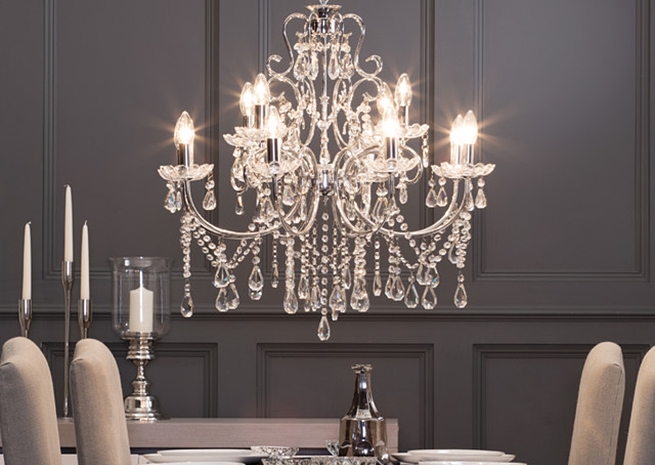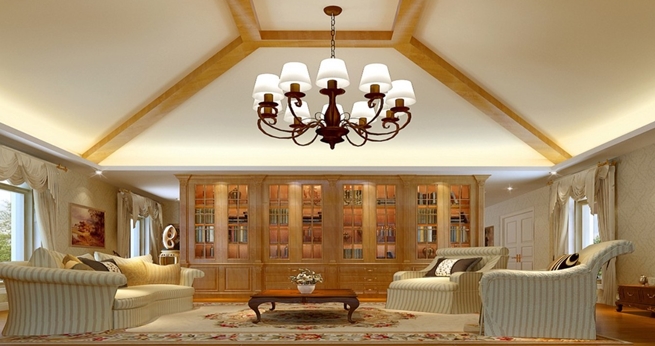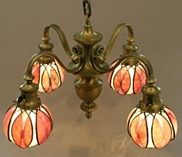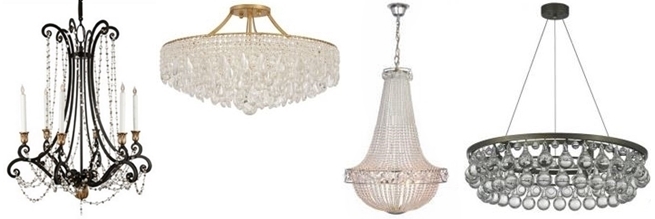
The term chandelier comes from chandelle, the French word meaning candle holder, which is derived from the Latin candelabrum. Sometime in the 14th century, someone had the brilliant idea to hang those candle holders from a ceiling… and the chandelier as we know it was born.
The candles that powered the first chandeliers were replaced by gas in the mid-19th century, with electricity taking over in the late 19th century.
From the very beginning, chandeliers were more than light fixtures. They were also a symbol of luxury and status.
The antique chandeliers we use in our homes today are as a rule replicas. If you do happen to come across an authentic antique chandelier, it has probably been converted to run on electricity.

Antique chandeliers can be made from a variety of materials, such as wood, metal, glass, crystal, brass, silver, bronze and iron. They also come in many different styles. Here are some of the most popular:
 Murano chandeliers have multiple arms decorated with garlands, flowers and leaves. The simpler models have glass arms, while the bigger, more sumptuous Murano chandeliers have a metal frame covered with pieces of transparent or coloured blown glass. These are often used for the lighting of theatres and rooms in palaces. The first Murano glass chandeliers were made by Venetian glassmakers in about 1700. They are still produced in Venice today.
Murano chandeliers have multiple arms decorated with garlands, flowers and leaves. The simpler models have glass arms, while the bigger, more sumptuous Murano chandeliers have a metal frame covered with pieces of transparent or coloured blown glass. These are often used for the lighting of theatres and rooms in palaces. The first Murano glass chandeliers were made by Venetian glassmakers in about 1700. They are still produced in Venice today.
French chandeliers are refined and elegant, but at the same time impressive and romantic. Many of them have natural motifs, from animals and plants to human faces. Their elaborate style and high cost make French chandeliers suitable for public and commercial buildings and the grand homes of the wealthy.
Empire chandeliers were designed during the reign of Napoleon. They are stately and dignified, with many intricate filigrees and strings of crystals.
Victorian chandeliers usually have multiple strands of glass beads or crystals. They often incorporate lamp shades made of glass or fabric and decorated with ornate scrolls and curves. Today, this style is often associated with shabby chic.
 Art Nouveau style emerged in the 19th century as a reaction to classic canons. With its smooth curves and lines, this style aspires to natural harmony and makes ample use of motifs such as flowers, plants, insects, fairies and elves. Typical Art Nouveau chandeliers give soft light and are sometimes decorated with stained glass patterns.
Art Nouveau style emerged in the 19th century as a reaction to classic canons. With its smooth curves and lines, this style aspires to natural harmony and makes ample use of motifs such as flowers, plants, insects, fairies and elves. Typical Art Nouveau chandeliers give soft light and are sometimes decorated with stained glass patterns.
Art Deco chandeliers make a bold statement with geometric shapes and floral motifs in glass and metal. They are suitable for both casual and formal spaces.
Tiffany chandeliers are stained glass works of art. They are produced in many colours, which makes them suitable for a wide variety of interiors.
The antique chandeliers section on bidorbuy has a great selection of these decorative ceiling-mounted light fixtures to suit a variety of interior designs and give every room special character.










